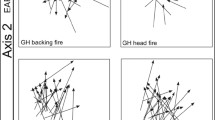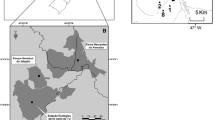Abstract
Some invasive grasses have been reported to change fire behavior in invaded plant communities. Urochloa brizantha is an aggressive invasive grass in the Brazilian Cerrado, an ecosystem where fire is a common disturbance. We investigated the effects of U. brizantha on fire behavior in an open Cerrado physiognomy in Central Brazil. Using experimental burnings we compared fire behavior at both the community and the individual plant level in invaded (UJ) and non-invaded (NJ) areas burned in July. We also assessed the effect of fire season in invaded areas by comparing July (UJ) and October (UO) burnings. We evaluated the following variables: fuel load, fuel moisture, combustion efficiency, maximum fire temperature, flame height, and fire intensity. Additionally, we evaluated the temperatures reached under invasive and native grass tussocks in both seasons. Fuel load, combustion efficiency, and fire intensity were higher in NJ than in UJ, whilst flame height showed the opposite trend. Fuel amount and fire intensity were higher in October than in July. At the individual plant level, U. brizantha moisture was higher than that of native species, however, temperatures reaching ≥600 °C at ground level were more frequent under U. brizantha tussocks than under native grasses. At the community level, the invasive grass modified fire behavior towards lower intensity, lower burning efficiency, and higher flame height. These results provide essential information for the planning of prescribed burnings in invaded Cerrado areas.



Similar content being viewed by others
References
AER (2009) Elaboração do diagnóstico ambiental e zoneamento da Reserva, Natural Serra do Tombador, Calvalcante, GO
Almeida-Neto M, Prado PI, Kubota U et al (2010) Invasive grasses and native Asteraceae in the Brazilian Cerrado. Plant Ecol 209:109–122. doi:10.1007/s11258-010-9727-8
Bilbao B, Medina E (1996) Types of grassland fires and nitrogen volatilization in tropical savannas of Calabozo, Venezuela. In: Levine LS (ed) Biomass burn and global change. MIT Press, Cambrigde, pp 569–574
Bond WJ, Midgley JJ (1995) Kill thy neighbour : an Individualistic argument for the evolution of flammability for the evolution kill thy neighbour : an individualistic argument of flammability. Oikos 73:79–85
Bova AS, Dickinson MB (2005) Linking surface-fire behavior, stem heating, and tissue necrosis. Can J For Res 822:814–822. doi:10.1139/X05-004
Brooks ML, Antonio CMD, Richardson DM et al (2004) Effects of invasive alien plants on fire regimes. Bioscience 54:677–688
Castro EA, Kauffmann JB (1998) Ecosystem structure in the Brazilian Cerrado : a vegetation gradient of aboveground biomass, root mass and consumption by fire. J Trop Ecol 14:263–283
Coutinho Leopoldo M (1978) O conceito de cerrado. Rev Bras Botânica 1:17–23
Cronk QCB, Fuller JL (1995) Plant invaders: the threat to natural ecosystems. Chapman & Hall, London
D’Antonio CM (2000) Fire, plant invasions and global change. In: Mooney H, Hobbs R (eds) Invasive species in a changing world. Island Press, Washington, pp 65–94
D’Antonio C, Vitousek P (1992) Biological invasions by exotic grasses, the grass/fire cycle, and global change. Annu Rev Ecol Syst 23:63–87
D’Antonio CM, Hugles FR, Mack MC et al (1998) The response of native species to removal of invasive exotic grasses in a seasonally dry Hawaiian woodland. J Veg Sci 9:699–712. doi:10.2307/3237288
Durigan G, de Siqueira MF, Franco GADC (2007) Threats to the Cerrado remnants of the state of São Paulo, Brazil. Sci Agric 64:355–363. doi:10.1590/S0103-90162007000400006
Fidelis A, Lyra MFDS, Pivello VR (2013) Above- and below-ground biomass and carbon dynamics in Brazilian Cerrado wet grasslands. J Veg Sci 24:356–364. doi:10.1111/j.1654-1103.2012.01465.x
Filgueiras TS (1992) Gramíneas Forrageiras no Distrito Federal, Brasil. Pesqui Agropecuária Bras 27:1103–1111
Griffin GF, Friedel MH (1984) Effects of fire on central Australian rangelands. I. fire and fuel characteristics and changes in herbage and nutrients. Aust J Ecol 9:381–394
Hughes F, Vitousek PM (1993) Barriers to shrub reestablishment following fire in the seasonal submontane zone of Hawai’i. Oecologia 93:557–563. doi:10.1007/BF00328965
Kauffmann JB, Cummings DL, Ward DE (1994) Relationships of fire, biomass and nutrient dynamics along a vegetation gradient in the Brazilian Cerrado. J Ecol 82:519–531
Klinger RC (2011) Fire regime. In: Simberloff D, Rejmánek M (eds) Encyclopedia Biological Invasions. University of California Press, Berkeley, CA, pp 223–228
Klink CA (1994) Effects of clipping on size and tillering of native and African grasses of Brazilian savannas (the Cerrado). Oikos 70:365–376
Klink CA, Machado RB (2005) Conservation of the Brazilian Cerrado. Conserv Biol 19:707–713. doi:10.1111/j.1523-1739.2005.00702.x
Lannes LS, Bustamante MMC, Edwards PJ, Venterink HO (2012) Alien and endangered plants in the Brazilian Cerrado exhibit contrasting relationships with vegetation biomass and N: p stoichiometry. New Phytol 196:816–823. doi:10.1111/j.1469-8137.2012.04363.x
Mack MC, Antonio CMD (1998) Impacts of biological invasions on disturbance regimes. Trends Ecol Evol 13:195–198
Mack RN, Simberloff D, Lonsdale WM et al (2000) Biotic invasions: causes, epidemiology, global consequences, and control. Ecol Appl 10:689–710
Mcdonald CJ, Mcpherson GR (2013) Creating hotter fires in the Sonoran Desert: buffelgrass Produces copius fuels and high fire temperatures. Fire Ecol 9:26–39. doi:10.4996/fireecology.0902026
McGranahan DA, Engle DM, Fuhlendorf SD et al (2012) An invasive cool-season grass complicates prescribed fire management in a native warm-season grassland an invasive cool-season grass complicates prescribed fire management in a native warm-season grassland. Nat Areas J 32:208–214
McGranahan DA, Engle DM, Miller JR, Debinski DM (2013) An invasive grass increases live fuel proportion and reduces fire spread in a simulated grassland. Ecosystems 16:158–169. doi:10.1007/s10021-012-9605-4
Milles JW, Maass BL, Valle CB, Kumble V (1996) Brachiaria: biology, agronomy, and improvement. EMBRAPA/CNPGC (CIAT Publication no. 259), Cali
Miranda AC, Miranda HS, de Dias I FO, Dias BF S (1993) Soil and air temperatures during prescribed cerrado fires in Central Brazil. J Trop 9:313–320
Miranda HS, Bustamante MMC, Miranda AC (2002) The fire factor. In: Olivera P, Marquis R (eds) The Cerrados of Brazil. Ecology and Natural History of a Neotropical Savanna. Columbia University Press, New York, pp 51–68
Miranda HS, Sato MN, Neto WN, Aires FS (2009) Fire in the Cerrado, the Brazilian savanna. In: Cochrane MA (ed) Tropical fire ecology: climate change, land use, and ecosystem dynamics. Springer-Praxis, Heidelberg, pp 427–450
Mistry J, Berardi A (2005) Assessing fire potential in a Brazilian savanna nature reserve. Biotropica 37:439–451
Myers N, Mittermeier RA, Mittermeier CG et al (2000) Biodiversity hotspots for conservation priorities. Nature 403:853–858
Oliveras IA, Meirelles ST, Hirakuri VL et al (2013) Effects of fire regimes on herbaceous biomass and nutrient dynamics in the Brazilian savanna. Int J Wildl Fire 22:368–380
Pérez B, Moreno JM (1998) Methods for quantifying fire severity in shrubland-fires. Plant Ecol 139:91–101
Pillar V (2005) MULTIV: multivariate exploratory analysis, randomization testing and bootstrap resampling
Pimentel D, Lach L, Zuniga R, Morrison D (2000) Environmental and economic costs of nonindigenous species in the United States. Bioscience 50:53–55
Pivello V, Carvalho V, Lopes P (1999a) Abundance and distribution of native and alien grasses in a “Cerrado”(Brazilian savanna) biological reserve1. Biotropica 31:71–82
Pivello VR, Shida CN, Meirelles ST (1999b) Alien grasses in Brazilian savannas : a threat to the biodiversity. Biodivers Conserv 8:1281–1294
Pivello VR (2006) Manejo de fragmentos de cerrado: princípios para a conservação da biodiversidade. In: Scariot A, Sousa Silva JC, Felfili JM (eds) Cerrado: ecologia, biodiversidade e conservação. Ministério do Meio Ambiente, Brasília, pp 402–413
Pyšek P, Jarošík V, Hulme PE et al (2012) A global assessment of invasive plant impacts on resident species, communities and ecosystems: the interaction of impact measures, invading species’ traits and environment. Glob Chang Biol 18:1725–1737. doi:10.1111/j.1365-2486.2011.02636.x
Rossiter NA, Setterfield SA, Douglas MM, Hutley LB (2003) Testing the grass-fire cycle: alien grass invasion in the tropical savannas of northern Australia. Divers Distrib 9:169–176. doi:10.1046/j.1472-4642.2003.00020.x
Setterfield S, Rossiter-Ranchor NA, Hutley LB et al (2010) Turning up the heat: the impacts of Andropogon gayanus (gamba grass) invasion on fire behaviour in northern Australian savannas. Divers Distrib 16:854–861. doi:10.1111/j.1472-4642.2010.00688.x
Simon MF, Grether R, de Queiroz LP et al (2009) Recent assembly of the Cerrado, a neotropical plant diversity hotspot, by in situ evolution of adaptations to fire. Proc Natl Acad Sci USA 106:20359–20364. doi:10.1073/pnas.0903410106
Statsoft Inc (2007) STATISTICA (data analysis software system), version 8.0. www.statsoft.com
Vilà M, Espinar JL, Hejda M et al (2011) Ecological impacts of invasive alien plants: a meta-analysis of their effects on species, communities and ecosystems. Ecol Lett 14:702–708. doi:10.1111/j.1461-0248.2011.01628.x
Whelan RJ (1995) The ecology of fire. Cambridge University Press, Cambridge
Acknowledgments
We thank the Fundação Grupo Boticário de Proteção à Natureza (Termo de Parceria No 0106_2011_PR), Conselho Nacional de Desenvolvimento Científico e Tecnológico (CNPq), the Coordenação de Aperfeiçoamento de Pessoal de Nível Superior (CAPES/DGU 227/2010), and the Ministry of Education (PHB2009-0073-PC) and of Science and Innovation (FEEDBACK Project; CGL2011-30515-C02-01) of the Spanish Goverment for financial support. We are grateful to Jonathan Galdi Rosa and Heloíza Lourenço Zirondi for their help during the fire experiments. We also thank the fire fighters from the Serra do Tombador Nature Reserve for their remarkable help during fieldwork and fire experiments. Finally we thank the editor and two anonymous reviewers for their contribution.
Author information
Authors and Affiliations
Corresponding author
Rights and permissions
About this article
Cite this article
Gorgone-Barbosa, E., Pivello, V.R., Bautista, S. et al. How can an invasive grass affect fire behavior in a tropical savanna? A community and individual plant level approach. Biol Invasions 17, 423–431 (2015). https://doi.org/10.1007/s10530-014-0740-z
Received:
Accepted:
Published:
Issue Date:
DOI: https://doi.org/10.1007/s10530-014-0740-z




